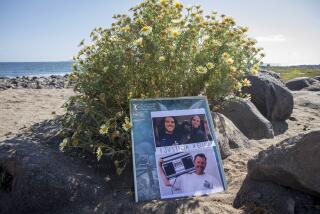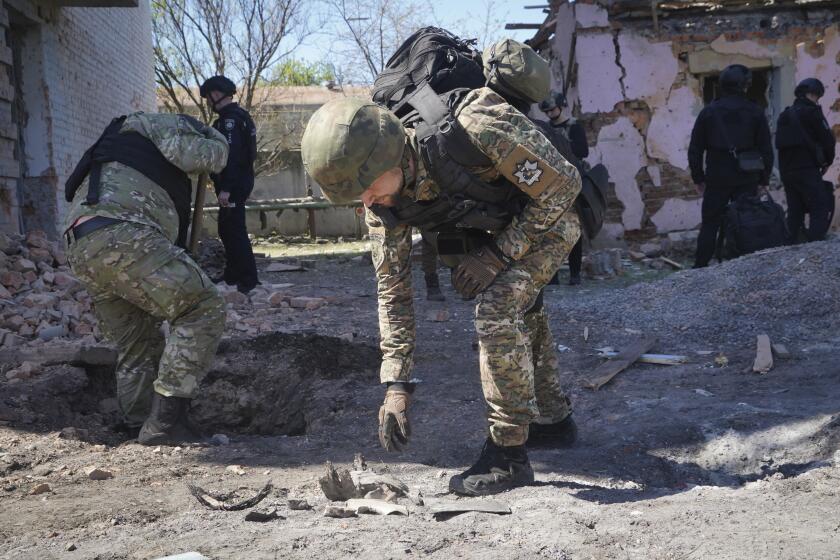Danger From 2 Reactors on Kursk Seen as Minimal
The danger posed by two nuclear reactors aboard a crippled Russian submarine appears to be slight, at least for the time being, several U.S. nuclear analysts said Monday.
As of late Monday, no elevated levels of radioactivity in the air or water had been detected by a Norwegian intelligence vessel stationed in the area near where the Kursk, one of the largest undersea craft in Russia’s submarine fleet, plunged hundreds of feet to the sea floor.
Compared with a commercial reactor, the heavily shielded nuclear reactors that power a submarine are small, emitting a fraction of the dangerously radioactive byproducts that commercial reactors do, experts said. The nuclear fuel itself is a solid metal. If, as believed, the reactors aboard the Kursk are still protected by intact containment vessels and the submarine’s pressure hull itself still isn’t breached, there is little likelihood of a radioactive fuel leak.
“You are talking about thousands of years before you would have to be concerned,” said Thomas Cochran, director of nuclear programs at the Natural Resources Defense Council, an environmental group in Washington that closely monitors nuclear issues.
“Given how many submarines and bombs are down there [in the ocean] already, I don’t think there is any significant hazard,” Cochran said. “The thing is intact and protected, so the risk associated with radiation pollution from this one sub does not represent a hazard.”
In all, there are at least two U.S. nuclear submarines and four Soviet-era nuclear submarines wrecked on the ocean bottom, along with as many as 50 nuclear warheads. One of the Soviet subs, which sank in the Atlantic Ocean off Bermuda, went down carrying 16 nuclear missiles; both U.S. submarines broke up as they sank. Even so, there has been little significant radioactivity detected from the wrecks so far, the U.S. analysts said.
In addition, Russia has routinely disposed of spent nuclear reactors by dumping them in the ocean.
Crew members managed to shut down the reactors safely as the Kursk sank to the bottom of the Barents Sea near the Arctic Circle, according to initial official reports. Although the submarine is designed to carry two dozen tactical nuclear missiles, Russian officials said none were on board.
U.S. experts, however, cautioned that very little was known about the extent of damage to the craft.
All four of the Soviet submarines that sank belonged, like the crippled Kursk, to Russia’s Northern Fleet. That fleet has a long history of accidents, fires and equipment problems in its nuclear-powered vessels, according to the Bellona Foundation, a Norwegian environmental group that monitors the Northern Fleet. Seven of the 10 major nuclear accidents in Russian submarines have occurred in craft operated by the Northern Fleet.
In all, 507 people have died in accidents aboard Russian nuclear craft. Many more have suffered overexposure to radiation, the Bellona Foundation said in a recent report on the fleet’s problems.
In the last major accident, in April 1989, the submarine Komsomolets sank after catching fire 200 miles north of Norway. Forty-two of the 69 Soviet sailors aboard were killed in the accident, and the wrecked hull with its reactor still lies on the sea bottom.
(BEGIN TEXT OF INFOBOX / INFOGRAPHIC)
Facts About the Kursk
The cruise missile submarine Kursk is part of the Russian navy’s defense against enemy aircraft carriers:
*
NATO classification: Oscar II
Launched: May 1994, commissioned for service January 1995; one of navy’s newest vessels
Purpose: To tail enemy aircraft carriers and escorting warships and destroy if ordered
Engines: Two nuclear reactors
Crew: Kursk carries 107, including 48 officers; maximum crew 130
Weapons: Up to 24 Chelomey SS-N-19 Shipwreck missiles, or torpedoes or anti-submarine Novator missiles. All 24 can be fired simultaneously.
*
Missiles: Kursk is carrying conventional warheads, but these missiles can be outfitted with nuclear warheads.
Insight: Huge size makes sub difficult to maneuver and slow to dive, which is not a handicap in its role of attacking carrier groups from a distance. Has sophisticated noise- suppression system that makes it difficult to detect.
*
Sources: Associated Press, Reuters, Jane’s Fighting Ships, 1998-1999, U.S. Naval Institute Military Database; researched by JANET LUNDBLAD and VICKY McCARGAR/Los Angeles Times
More to Read
Start your day right
Sign up for Essential California for news, features and recommendations from the L.A. Times and beyond in your inbox six days a week.
You may occasionally receive promotional content from the Los Angeles Times.






